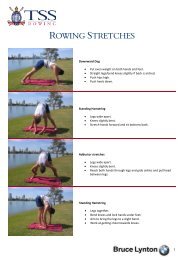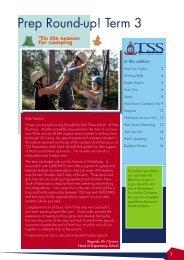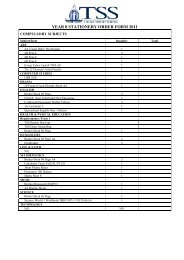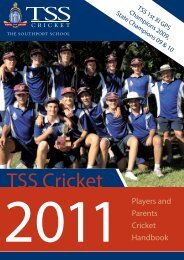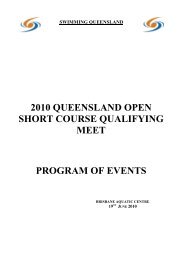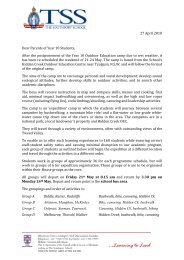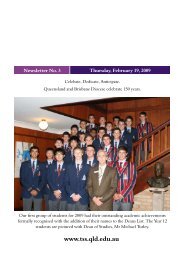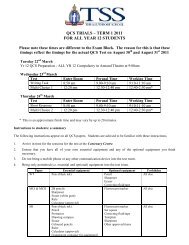About Boys - The Southport School
About Boys - The Southport School
About Boys - The Southport School
You also want an ePaper? Increase the reach of your titles
YUMPU automatically turns print PDFs into web optimized ePapers that Google loves.
This booklet has been<br />
prepared by interested<br />
and concerned professional<br />
educators at <strong>The</strong> <strong>Southport</strong><br />
<strong>School</strong> to help parents in the<br />
very important - and at times<br />
demanding - role of assisting their<br />
sons to grow to their full potential<br />
and to take their proud place as<br />
members of our adult community.<br />
We hope you find it useful, and would<br />
be very pleased to hear from any who have<br />
further suggestions to improve its usefulness in<br />
subsequent editions.<br />
Enjoy the booklet and enjoy raising your sons<br />
to be fine young men!
<strong>The</strong> following are a few facts<br />
we know about boys<br />
<strong>Boys</strong> under-perform<br />
compared with girls<br />
in literacy tests at<br />
both Year 3 and Year<br />
6 in Government<br />
schools. This<br />
result is replicated<br />
throughout the<br />
school system.<br />
<strong>Boys</strong> achieve<br />
notably lower<br />
grades in English<br />
at both <strong>School</strong><br />
Certificate Level<br />
and Higher <strong>School</strong><br />
Certificate. (NSW).<br />
<strong>Boys</strong> perform better<br />
in numeracy tests at<br />
Years 3 and 6.<br />
Girls have<br />
outperformed boys<br />
over the past 13<br />
years on the basis<br />
of the mean TES<br />
(Tertiary Entrance<br />
Scores).<br />
2003 Queensland<br />
Tertiary Admissions<br />
Centre Annual<br />
Report indicates<br />
that at all upper<br />
OP bands except<br />
OP Band 1 females<br />
outnumber males.<br />
<strong>The</strong> difference at<br />
Band 1 and 2 is<br />
only 0.4% of all<br />
students qualifying<br />
for an OP; however,<br />
at Band 4 the<br />
difference is 18 %.<br />
More girls than boys<br />
stay on to complete<br />
Year 12 (2002:<br />
20,165 girls 19,149<br />
boys in Queensland)<br />
<strong>Boys</strong> are twice as<br />
likely as girls to be<br />
labelled "learning<br />
disabled"<br />
<strong>Boys</strong> are under<br />
represented in<br />
the total available<br />
University and TAFE<br />
places.<br />
<strong>Boys</strong> can be<br />
uncommunicative.<br />
<strong>The</strong>y will not<br />
talk about their<br />
problems. However<br />
the majority of<br />
students needing<br />
welfare assistance<br />
are boys.<br />
<strong>Boys</strong> have fewer<br />
alternative dispute<br />
resolution skills<br />
than girls and<br />
sometimes see<br />
physical conflict as<br />
an acceptable way<br />
to resolve problems.<br />
Studies suggest<br />
that a boy's self<br />
esteem is more<br />
fragile than that of<br />
a girl and the rate<br />
of depression<br />
among boys is<br />
alarmingly high.<br />
<strong>Boys</strong> are four to six<br />
times more likely to<br />
commit suicide.<br />
90% of cases of<br />
Attention Deficit<br />
Hyperactivity<br />
Disorder (A.D.H.D.)<br />
are boys.<br />
By age 15 boys are<br />
three times more<br />
likely to die from<br />
any cause - but<br />
particularly from<br />
accidents, violence<br />
and suicide.
<strong>The</strong> Construction of Masculinity<br />
“Our culture co-opts some of the most impressive<br />
qualities boys can possess - their physical energy,<br />
boldness, curiosity, and action orientation - and<br />
distorts them into a punishing dangerous definition<br />
of masculinity”<br />
(Kindlon D, & Thompson M. Raising Cain)<br />
It should be clear from the these facts that the<br />
picture of a boy's life as we enter a new century is<br />
a challenging one. A disproportionate number of<br />
boys are not achieving academically, many develop<br />
behaviour problems, have dangerously low self<br />
esteem, drop out of school, and in some instances<br />
decide that life is no longer worth living.<br />
Dr. William Pollack, Clinical Psychologist and<br />
Co-Director, Centre for Men, McLean Hospital<br />
Harvard Medical <strong>School</strong>, in his book ‘Real<br />
<strong>Boys</strong>’, suggests that many of the dilemmas<br />
faced by boys today arise from adherence<br />
in our society to what he calls the Boy<br />
Code - “the outdated and constricting<br />
assumptions, models and rules about<br />
boys that our society has used since the<br />
nineteenth century”.
Briefly, the Boy Code states that boys assume from a very<br />
early age a mask of masculinity. <strong>The</strong>y learn to be ashamed<br />
and guilty about feelings of weakness, vulnerability, fear<br />
and despair. It demands that boys be disciplined, toughened<br />
up, made to act like ‘real men’. <strong>The</strong>se messages and attitudes,<br />
Pollack argues, are quite insidious and permeate even the most<br />
liberal thinking households and schools and stand in obvious<br />
contradiction to the new expectations of society for the development<br />
of caring, sharing, sensitive ‘new age’ men.<br />
<strong>The</strong>re exist four basic stereotyped male ideals or models of behaviour<br />
at the heart of the Boy Code.<br />
> <strong>The</strong> ‘sturdy oak.’ Men are stoic, stable, and independent; they<br />
do not show emotion and do not grieve openly. <strong>Boys</strong> should<br />
pretend to be confident and independent even though they may<br />
be afraid and be desperate for love, attention and support.<br />
> ‘Give ’em hell.’ This stereotype is based on the assumption<br />
that ‘boys are biologically wired to act like macho high-energy<br />
violent supermen. <strong>The</strong>se images of exaggerated stoicism,<br />
violent, impossibly-powerful supermen, are everywhere in film<br />
on television, computer and video screens’.<br />
> <strong>The</strong> ‘big wheel’ This represents the belief that men<br />
feel the need to achieve status, dominance and power.<br />
This imperative may drive a man to work excessive hours<br />
chasing academic or business success. Alternatively he<br />
may chase riches through gambling or status through<br />
excessive alcohol consumption.<br />
> ‘No sissy stuff’ This model of male behaviour is a<br />
cornerstone of the Boy Code. ‘It is the literal gender<br />
straightjacket that prohibits boys from expressing the<br />
feelings or urges seen (mistakenly) as 'feminine' -<br />
dependence, warmth, empathy.’ This faulty perception<br />
of masculinity demands that boys shut out these<br />
feelings. Should they be displayed, then the taunts,<br />
threats and shame that result will make a boy<br />
determined never to act that way again.<br />
As parents, educators and communities, we must<br />
strive to counter these myths of masculinity and
challenge what we know to be outmoded<br />
views of what it means to<br />
be male served up to our boys by profit<br />
driven media.<br />
We must protect and nurture the emotional<br />
lives of our boys, to help them to feel<br />
comfortable with whom they really are and to<br />
get out from behind the mask of masculinity.<br />
Pollack suggests there are some starting points<br />
for teachers and parents to get behind the<br />
mask of masculinity and to find out who our<br />
boys really are;<br />
> Become aware that the behaviours that we<br />
sometimes observe in our boys, the bravado, the<br />
acting out, uncharacteristic violence or withdrawal<br />
and sullen silence, may in fact be masking feeling<br />
and emotions that the boy does not have the<br />
vocabulary to explain. Counsellors know that the<br />
most common answer they get from a boy in trouble,<br />
initially, is that ‘everything's fine... there's nothing<br />
to talk about’<br />
> We are unlikely to have a boy tell us how he is<br />
feeling if we come to the discussion from a punishment<br />
or correction stance. More successful is a problem<br />
solving approach starting from a point of view that<br />
‘things do not seem to be working out too well. How<br />
could things be different or better?’<br />
> <strong>Boys</strong> need time to let us know how they feel about<br />
things; we should attempt to become familiar with each<br />
boy's unique timing for disclosing his feelings.<br />
> ‘Connection through action’. Pollack argues that many boys<br />
are more likely to ‘open up’ while engaged in some sort of<br />
activity. Hence this connection, for which many boys long, to<br />
their parents, coaches, teachers, friends and families will occur<br />
naturally when engaged in some form of activity. <strong>The</strong> message is<br />
clear that we must be involved in our boys' lives and they in ours.<br />
<strong>The</strong> dialogue that comes from this involvement must be free, open<br />
and accepting of the full range of emotional experiences.
<strong>The</strong> widely acclaimed psychologist and author<br />
on raising boys Steve Biddulph suggests there<br />
are three distinct stages in boyhood - maybe<br />
you recognise them...<br />
From Birth to about Six<br />
At this stage, boys essentially belong to their<br />
Mums. Gender differences are not important<br />
although there are some studies suggesting that<br />
mothers and fathers relate differently to male and<br />
female infants. As toddlers, personalities start to<br />
emerge and boys and girls may be either placid and<br />
easy going or fractious, anxious, active and difficult<br />
to settle. <strong>The</strong>re are tendencies for boys to be more<br />
active in their play, to prefer to handle concrete<br />
objects and not to be as welcoming of strangers to<br />
their play.<br />
From about Six to Fourteen<br />
During this stage boys start to look more to Dad or<br />
the significant male figure in their life for interest<br />
and activity. <strong>The</strong>y learn from this male and copy<br />
his behaviours. Mum remains important but in a<br />
sense the boy is studying how it is to be a male.<br />
It is important to note that this change<br />
of focus from mother to father should<br />
be natural and at the boy’s own pace.<br />
It is not something that needs to<br />
be forced as in a ‘toughening up’ or<br />
‘severing of apron strings’. This would<br />
simply be a perpetuation of the ‘Boy<br />
Code’ referred to elsewhere in this<br />
booklet which suggests that boys need<br />
to disconnect from their mothers ‘for<br />
their own good’. At this stage Biddulph<br />
suggests that fathers need to increase<br />
their involvement with their sons. Where<br />
there is not a father around boys may<br />
look to other significant males for<br />
example an uncle, neighbour, teacher or<br />
sports coach. Obviously, the presence<br />
of significant adult males is very<br />
important at this time.<br />
0 5 10 15 20 25 30 35 40 45 50 55 60 65 70 75 80 85 90 95 100 105 110 115 120 125 130 135 140 145 150 155 160 165 170 17
From about Fourteen to Adulthood<br />
For many boys this is a critical period. <strong>The</strong> male<br />
hormone, testosterone, has ‘kicked in’, physical<br />
changes are taking place, and there is a hunger for<br />
adventure, new challenges and risk taking. Also at this<br />
time there can be massive mood swings from being<br />
exited and ‘fired up’ to being bored and depressed.<br />
<strong>Boys</strong> search for something to be a part of, to belong<br />
to and to develop a passion about. <strong>The</strong>y may get ‘into’<br />
music, cars and motorbikes, surfing or some other<br />
sport. Sadly some that cannot make these connections<br />
may seek excitement, challenges and acceptance in<br />
destructive ways through criminal activity, drug taking<br />
and gang membership.<br />
<strong>The</strong> successful and safe passage from boyhood to<br />
manhood is largely dependent on having these energies<br />
channelled by good adult male mentors. People who<br />
listen, provide wise counsel, act as role models, care<br />
and are willing to share openly and honestly their<br />
own feelings and experiences.
We all need to feel that we belong.<br />
<strong>Boys</strong> in particular in the second<br />
and third stages of development<br />
begin to feel this need most<br />
keenly. Pollack calls this<br />
‘emotional connection’ - the<br />
need to find people who<br />
think and feel as we do<br />
and accept us by validating<br />
our feelings and experiences.<br />
Happily, most boys find these<br />
connections with friends,<br />
family members, teachers and<br />
coaches.<br />
Unfortunately, for some, the Boy Code<br />
and the mask of masculinity can distort<br />
these connections. <strong>The</strong> myths of what it is<br />
to be masculine which are fed to us in a variety of<br />
subtle and not so subtle ways cause some boys to develop<br />
inappropriate ways of belonging.<br />
<strong>The</strong>se are reflected in four general modes of behaviour.<br />
> “I belong when I am noticed and the centre of<br />
attention.” This belief leads to attention seeking and<br />
showing off. Many boys who hold this belief are incorrectly<br />
labelled A.D.H.D. A pattern of ignoring a boy until he<br />
breaks something, hits a sibling or ‘waves a flag’ in<br />
some other way, and then responding, will reinforce this<br />
attention-seeking behaviour.<br />
> “I belong when I am in control.” <strong>Boys</strong> who see<br />
only powerful men or who believe power and control<br />
to be defining male characteristics may demonstrate<br />
inappropriate behaviours based on power struggles. <strong>The</strong>ir<br />
self worth and sense of belonging is enhanced when they<br />
are in conflict with those they perceive to have more<br />
power. Typically they argue over the smallest issue or<br />
seem deliberately to provoke an argument. This may be<br />
done by engaging in an activity which they know will<br />
‘rattle the cage’ of parents and teachers or alternatively<br />
by failing to do something which is required of them.
Increasingly it is thought that these gender<br />
differences are linked with dominance of either<br />
> “I belong when I hurt those who have hurt me.” As an<br />
individual or as part of a peer group, if a boy feels he<br />
has been treated unfairly then behaviour designed to<br />
hurt others can result. <strong>The</strong>ft from family members,<br />
graffiti, vandalism or the senseless destruction of<br />
public property is behaviour designed to hurt others.<br />
Essentially these behaviours are masking emotional<br />
pain that these boys have buried.<br />
> “I belong when I am helpless.” <strong>Boys</strong> who<br />
develop this mode of belonging are less common.<br />
Typical patterns of behaviour are displays of<br />
inadequacy, or withdrawal from situations.<br />
<strong>The</strong>ir self worth is dependent on being the<br />
person who always needs to be helped or<br />
rescued from situations.<br />
It is widely accepted that people have three<br />
learning modalities<br />
> Visual - learning by seeing things<br />
> Auditory - learning by hearing or being told<br />
about things<br />
> Kinesthetic - learning by doing things<br />
It is true that learning occurs best when all<br />
three modalities are harnessed; in fact, good<br />
teaching should strive to do this. <strong>The</strong>re is a<br />
saying, “Tell me and I will forget, show me<br />
and I might remember, involve me and I will<br />
understand.” It is also true that people have<br />
preferred modalities or learning styles.<br />
<strong>The</strong>re is some evidence to suggest that gender<br />
differences exist in relation to preferred styles<br />
of learning and processing information.
the left or right hemispheres of the brain<br />
and the differential development of these<br />
hemispheres in males and females. Some general<br />
observations of learning patterns of boys find<br />
that in the early years they do better at those<br />
subjects that are based in logic, with fact and<br />
formula. <strong>Boys</strong> are practical problem solvers and<br />
have good spatial reasoning and mechanical<br />
ability. <strong>The</strong>se are right brain attributes. <strong>The</strong>y<br />
learn less well by listening but excel at rotating<br />
three-dimensional objects in their heads. <strong>The</strong>y<br />
are generally slower to develop language skills<br />
and are less able to articulate their feelings<br />
or empathise with the feelings of others (left<br />
brain functions) than girls at the same age.<br />
Generally boys are more active in their learning,<br />
they learn more by being shown and actively<br />
participating or doing.<br />
<strong>Boys</strong> prefer clear boundaries and parameters<br />
for their learning. <strong>The</strong>y want to know what<br />
the rules are and perform best when these are<br />
enforced fairly and consistently be that in a<br />
Physics classroom or the playground.<br />
Much has been written about boys and literacy<br />
problems. <strong>Boys</strong> are generally over represented<br />
in remedial literacy programs worldwide. It<br />
has been suggested that areas of the brain<br />
responsible for language develop more rapidly in<br />
girls than boys. Studies have shown that parents<br />
talk more to baby girls and are rougher and more<br />
active in their play with little boys.<br />
Effective educational environments, be that of<br />
the school or the home, should take into account<br />
these unique characteristics of boys’ learning.
Recognise and be accepting<br />
of a full range of emotions and<br />
feelings in your sons, not just<br />
those that are considered ‘manly’.<br />
Always be ready to challenge and<br />
question with your sons the ‘mask of<br />
masculinity’.<br />
> Provide positive role models to counter<br />
the too often portrayed notion of manhood<br />
as a combination of toughness, promiscuity,<br />
hard drinking and a willingness to solve every<br />
conflict with violence.<br />
> Monitor their media diet. Watch what they are<br />
watching. Discuss, make comment and show concern<br />
where this is warranted. <strong>The</strong> sneakier companies, fast<br />
food industry, the soft drink industry, the music industry<br />
and others, through the mass media, shape our boys images<br />
of themselves. Tell them when they are being ‘conned’.
Be active in their lives. Meet their friends. Become<br />
aware of the power of your parenting. Clarify your own<br />
values and be explicit about these. In forming their own<br />
value system, they will scrutinise yours. Don’t leave<br />
them wondering what your values are.<br />
> Have a plan for your son’s spiritual and moral development.<br />
Too many boys receive scant if any education in these<br />
important areas. Many times, it is not until a boy does<br />
something that is horrifically amoral, that we scratch our<br />
heads and wonder why he does not know right from wrong.<br />
Start moral education at an early age.<br />
> Be an informed parent. <strong>The</strong>re is a bibliography with<br />
books about boys and books for boys at the back of this<br />
booklet.<br />
> Expose boys to a wide range of cultures and points of<br />
view from an early age. As mentioned earlier, boys tend<br />
not to be accepting of ‘outsiders’ and to be intolerant of<br />
differences. Don’t wait until rigid prejudices are established<br />
before you talk with them about tolerance of differences.<br />
> Develop a multi-layered support system. <strong>Boys</strong> who<br />
have several strong support systems, for example,<br />
parents, grandparents, uncles, aunts, cousins, coaches<br />
teachers and caring adult mentors who run clubs and<br />
activities are less likely to get into serious difficulties.
Build your Teenager's self-esteem and enjoy<br />
being a parent again by Susan Barton. Anne<br />
Donovan, 2001.<br />
Raising <strong>Boys</strong> by Steve Biddulph, Finch Publishing,<br />
2004.<br />
Adolescence; a guide for parents by Michael<br />
Carr-Greg. Finch Publishing 2002.<br />
A Fine Young Man – what parents, mentors and<br />
educators can do to shape adolescent boys into<br />
exceptional men by Michael Gurian. Penguin<br />
Putnam, 1999.<br />
<strong>The</strong> Good Son – shaping the moral development<br />
of our boys and young men by Michael Gurian.<br />
Penguin Putnam, 1999.<br />
Boy Oh Boy, how to raise and educate boys<br />
by Dr Tim Hawkes. Pearson Educational, 2001.<br />
Raising Cain – protecting the emotional life<br />
of boys by Dan Kindlon and Michael Thompson.<br />
Michael Joseph, 1999.<br />
<strong>Boys</strong> Forward by Ian Lillico. www.boysforward.com,<br />
2002.<br />
<strong>The</strong> Men <strong>The</strong>y Will Become – the nature and nurture<br />
of male character by Eli H.M.D. Newberger. Perseus<br />
Books, 1999.<br />
Secret Men's Business – manhood, the big gig by John<br />
Marsden. Pan Macmillan, 1988.<br />
<strong>Boys</strong>' Stuff – boys talking about what matters by<br />
Wayne Martino. Crows Nest, 2001.<br />
<strong>Boys</strong> and Books by James Moloney. ABC Books, 2002<br />
Real <strong>Boys</strong> – rescuing our sons from the myths of<br />
boyhood by William Pollack. Random House, 2004.<br />
Real <strong>Boys</strong>' Voices by William Pollack. Scribe<br />
Publications, 2000.<br />
Heroes by Jim Stynes, Crows Nest, 2003.<br />
Speaking of <strong>Boys</strong> – answers to the most-asked<br />
questions about raising sons by Michael Thompson.<br />
Ballentine, 2000.
Reception – Year 2<br />
<strong>The</strong> kiss that missed by David Melling. Hodder, London 2002.<br />
Just like my dad by David Melling. Hodder, London 2002.<br />
<strong>The</strong> boing boing races by Bruce Whatley. Koala Books,<br />
Sydney 1999.<br />
Stickybeak by Hazel Edwards. Nelson, Melbourne, 1986.<br />
Just like you and me by David Miller. Hodder, Sydney 1999.<br />
Sebastian lives in a hat by <strong>The</strong>lma Catterwell.<br />
Omnibus Books, 1985.<br />
My mum and dad make me laugh by Nick Sharratt.<br />
Walker Books, London 1994.<br />
Rattletrap car by Phyllis Root Walker Books, London.<br />
I know a rhino by Charles Fuge. Koala Books, Sydney.<br />
Gordon’s got snookie by Lisa Shanahan. Allen & Unwin, 2002.<br />
Something else by Kathryn Cave. Viking, 1994.<br />
Years 3 – 5<br />
Rowan of Rin by Emily Rodda. Scholastic, 1993.<br />
Leaving no footprints by Elaine Forrestal. Puffin, 2001.<br />
Ramose Prince in exile by Carole Wilkinson. Black Dog Books, 2001.<br />
Chasing the break by Michael Pankridge. Black Dog Books, 2003.<br />
Sacked! by Rachel Flynn. Puffin, 2000.<br />
Grommet saves the world by James Moloney. Puffin, 2003.<br />
Boyz rule! Water rats by Felice Arena. Macmillan, 2003.<br />
<strong>The</strong> boy who could fly by Sally Gardiner. 2001.<br />
Tashi by Anna Fineberg. Allen & Unwin, 1995.
Years 6 – 7<br />
Stormbreaker by Anthony Horowitz. Walker Books, 2000.<br />
Artemis Fowl by Eoin Colfer. Viking, 2001.<br />
Wild magic by Tamora Pierce. Scholastic, 1993.<br />
Castaways of the Flying Dutchmen by Brian Jacques.<br />
Viking.<br />
Hatchet by Gary Paulsen. Pan, 1991.<br />
Specky Macgee by Felice Arena. Harper Collins, 2002.<br />
Lockie Leonard human torpedo by Tim Winton.<br />
Penguin 2003.<br />
Alex Jackson Grommet by Pat Flynn. UQP, 2001.<br />
Whistleman by Brian Ridden. Lothian 2000.
Years 8 – 10<br />
Holes by Louis Sachar. Bloomsbury, 2000.<br />
Flash Jack by Maureen McCarthy. Penguin, 2001.<br />
Hoot by Carl Hiassen. Macmillan, 2002.<br />
Lord of the nutcracker men by Iain Lawrence. Collins, 2002.<br />
City of the beasts by Isabel Allende. Harper Collins, 2002.<br />
Keeper by Mal Peet. Walker books, 2003.<br />
Airborn by Kenneth Oppel. Hodder Childrens, 2004.<br />
Sabriel by Garth Nix. Allen & Unwin, 2003.<br />
Mortal engines by Philip Reeve. Scholastic, 2001.<br />
<strong>The</strong> thief lord by Cornelia Funke. <strong>The</strong> Chicken House, 2002.<br />
Soldier boy : the true story of Jim Martin the youngest<br />
Anzac by Anthony Hill. Penguin, 2001.<br />
<strong>The</strong> house of windjammer by V.A. Richardson.<br />
Bloomsbury, 2003.<br />
Running dogs by Ken Catran. Harper Collins, 1998.<br />
Montmorency by Eleanor Updale. Scholastic, 2003.<br />
Lion boy by Zizou Corder.<br />
Penguin, 2003.<br />
Tomorrow when the war began<br />
by John Marsden. Pan, 1995.<br />
<strong>The</strong> Bridge to Wiseman’s cove<br />
by James Moloney. UQP, 1996
Years 11 – 12<br />
<strong>The</strong> lovely bones by Alice Sebold. Pan Macmillan, 2002.<br />
Northern lights by Philip Pullman. Scholastic, 1998.<br />
Four fires by Bryce Courtney. Penguin, 2002.<br />
<strong>The</strong> messenger by Markus Zusak. Pan Macmillan, 2002.<br />
Across the nightingale floor by Lian Hearn.<br />
Hodder Headline, 2003.<br />
48 shades of brown by Nick Earls. Penguin, 1999.<br />
<strong>The</strong> life of Pi by Yann Martel. Cannongate, 2003.<br />
1421 by Gavin Menzies. Bantam, 2002.<br />
Hover car racer by Matt Reilly. Pan, 2004.<br />
Three men in a raft by Ben Kozel. Pan, 2002.<br />
Lionheart by Jesse Martin. Allen & Unwin, 2002.<br />
Off the wing on a prayer by Matt Rogers. ESM, 2002.<br />
Harlequin by Bernard Cornwell. Harper Collins, 2001.<br />
Montana 1948 by Larry Watson. Pan, 1995.<br />
Generals die in bed by Charles Yale Harrison.<br />
Penguin, 2003.<br />
<strong>The</strong> horses too are gone by Michael Keenan.<br />
Bantam, 1998.<br />
Baudolino by Umberto Eco. Randon House, 2002.<br />
<strong>The</strong> Ayre affair by Jasper FForde. Hodder, 2001.<br />
We hope you have enjoyed reading this publication which<br />
has been prepared by staff of <strong>The</strong> <strong>Southport</strong> <strong>School</strong>. For more<br />
information on boys' education please visit our website:<br />
www.tss.qld.edu.au
<strong>The</strong><br />
<strong>Southport</strong><br />
<strong>School</strong><br />
Learning to Lead<br />
Anglican <strong>Boys</strong>' Boarding and Day <strong>School</strong><br />
Winchester Street,<br />
<strong>Southport</strong> 4215, Queensland<br />
Phone 07 5531 9944 Fax 07 5591 2124<br />
www.tss.qld.edu.au



